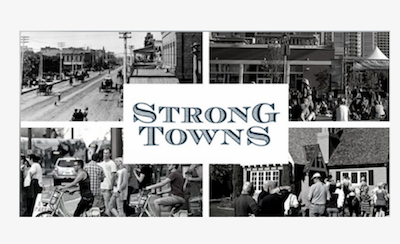Strong Towns’ guru speaks
Editor’s note: Charles Marohn, founder and president of Strong Towns, shared thoughts about Phoenix-area development during a 2018 visit. This article was written for LISC Phoenix, one of the sponsors of Marohn’s visit.
“Cities have the capability of providing something for everybody, only because, and only when, they are created by everybody.” — Jane Jacobs, “The Death and Life of Great American Cities”
The definition of insanity, the adage goes, is doing the same thing over and over again but expecting different results. Charles Marohn, founder and president of Strong Towns, argues that current development patterns force people, especially those in the Southwest, to live some variation of Crazytown, USA.
The horizontal expansion development patterns we see today make life unnecessarily difficult for some residents and are not sustainable long-term, Marohn said. Cities and towns can’t afford the post-World War II, automobile-centric, sprawl development pattern seen coast to coast, he said.
“You’re in a dysfunctional system designed to do a dysfunctional thing over and over again,” Marohn said.
“Phoenix, the state of Arizona, a lot of the Southwest, is designed to grow in a very certain, specific way. … Not only is the landscape perfectly adapted to that, but the structures that we’ve created — socially, politically, culturally, economically — are perfectly aligned to do that,” he said.
Last summer Marohn led a candid “Curbside Chat” (one of more than 300 he’s held nationwide) about development of cities and towns and was the featured speaker at events sponsored by LISC Phoenix, Local First, Downtown Voices Coalition, Downtown Phoenix Inc., RAILmesa, Sustainable Cities Network AZ, Sustainable Communities Collaborative, Urban Phoenix Project and Vitalyst Health Foundation.
LISC is a national organization with a community focus. LISC Phoenix was formed in 1992 to help revive blighted neighborhoods throughout metropolitan Phoenix. Working in collaboration with grassroots organizations and community partners, LISC Phoenix creates innovative solutions to problems faced by distressed, low-income neighborhoods.
LISC Phoenix initiatives, such as the Corridors of Retail Excellence (CORE), speak to some of the people-first community development principles championed by Strong Towns. CORE is a data-driven strategy that supports development and economic growth along five commercial corridors in low and moderate-income neighborhoods. CORE strategies develop from market assessments, on-the-ground surveys and collaboration with residents and business owners.

Strong Towns’ mission is to restore sanity to the places we call home by supporting a development model that encourages financial strength and resilience in cities, towns and neighborhoods. The organization believes “strong citizens (people who care),” collaboration, financial solvency, a meaningful transportation system, and sustainable land use are keys to stopping the madness.
Marohn told downtown Phoenix audiences that current U.S. development patterns — “the suburban experiment” — are a deviation from thousands of years of how civilizations grew and prospered.
Our ancestors knew what they were building; they followed a strong pattern of incremental development, Marohn said. They started small, taking low risks as they grew up within a core rather than building horizontally on the edges. Over time, buildings were constructed with more intensity: wood structures would be replaced with brick and granite.
Cities and towns back in the day lived within their means; they were able to pay their bills, he said. Today, not so much. Marohn calls today’s development pattern a growth Ponzi scheme that creates an illusion of wealth.
Because of decades of unproductive development, we have built more than we can take care of, Marohn said. Older, established neighborhoods are paying for themselves and contributing to city coffers; the rapid-fire new developments are not, leaving shortfalls when it comes time for public infrastructure upkeep or replacement, he said.
Historical development patterns recognized that complex natural systems are never based on efficiency; they are based on resiliency, adaptability and redundancy, Marohn said. But with modern development patterns, we’ve said cities and towns should be built and administered on an efficiency model. Marohn believes the efficiency model is designed to fail.
Strong Towns has adapted a Silicon Valley saying that innovation that happens from the top down tends to be orderly but dumb; innovation that happens from the bottom up tends to be chaotic but smart. Taking direction from the people for how to grow and development is a smart thing to do, Marohn said.
“We all have a preference for smart over dumb,” Marohn said. “But we have an enormously overwhelming preference, especially as an affluent society, for order over chaos. We will tolerate an incredible amount of dumb in order to have order.”
“How do you not get chaotic but dumb? I think you trust that people living in the community over time will not be dumb,” he said. “They’ll not migrate towards dumb. And if they do, that neighborhood will probably fail and go away.”
In the Phoenix metropolitan area, the impact of the 10-year CORE initiative, which has a transit-oriented development focus, has come into focus. LISC Phoenix and its partners have invested in five commercial corridors in Mesa, Tempe and Phoenix and have provided technical assistance to support ongoing grass-roots corridor management.
In four of the five corridors, population increased, largely as a result of investment in affordable housing. The percentage of low-income households also decreased from 2008 to 2018.
Marohn believes the best way North American cities and towns can get off the path of catastrophic failure is to turn planning and development on its head. Instead of trying to take a dysfunctional, professional top-down process and try to bend it to better ends, put people first in planning, he said.
Let neighborhoods be part of the solution, part of rescuing themselves, Marohn said. Observe where people struggle and make small investments to deal with those struggles, he said.
“Instead of saying, ‘Our goal is to do this to help them,’ what if we said, ‘Our goal is to help them?’ “
Marohn is convinced the outcomes of such a process would be very different than something that came from top-down efforts. It could help stitch neighborhoods back together, making them stronger, more resilient, and adaptable. It could improve lives, he said.
“Tactical urbanism” is part of a “Neighborhoods First” initiative championed by Strong Towns. It’s a citizen-led, low-cost approach to neighborhood building and incremental growth. It happens in the Phoenix metropolitan area with efforts such as tree plantings, Park(ing) Day, the Radiate PHX Pop-up Festival, Mesa temporary murals, and Mesa Movies on Main St. (Downtown Voices Coalition started an open source map that shows examples of tactical urbanism.)
“We need to step back and acknowledge that we may have the right motives in our heart, but we’re using a process designed to do something different than what we’re trying to accomplish,” Marohn said. “If we can pump ourselves to have a different approach, an approach that is messier, an approach that’s not as efficient, an approach that’s not necessarily tied into federal and state grant programs, an approach that’s not tied into redevelopers and large amounts of capital, but an approach that actually starts with the needs of the people in our community, I think we can, in a very low-risk, high-reward kind of way, build places that are productive, successful and great places to live.”
That doesn’t sound crazy at all.
